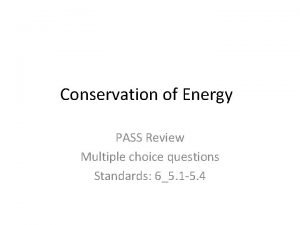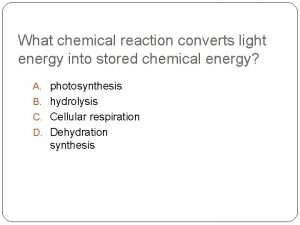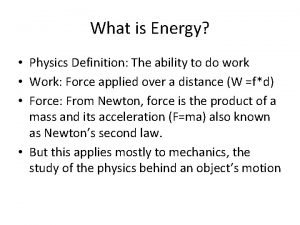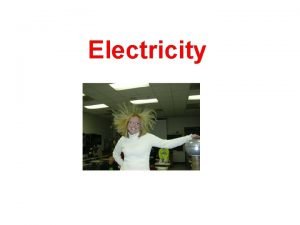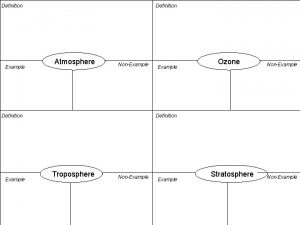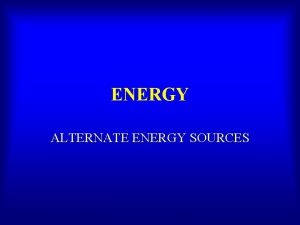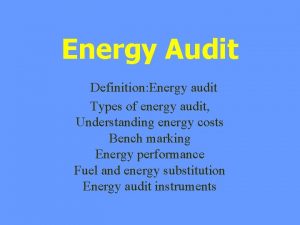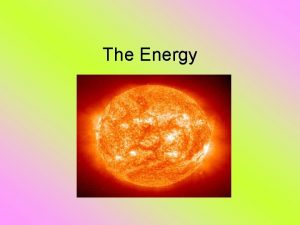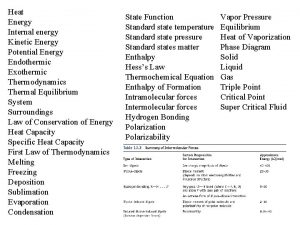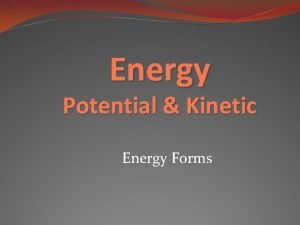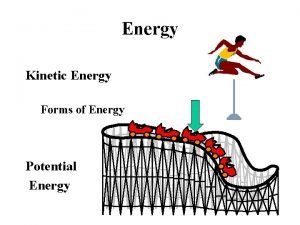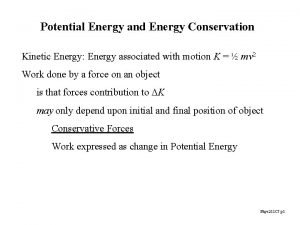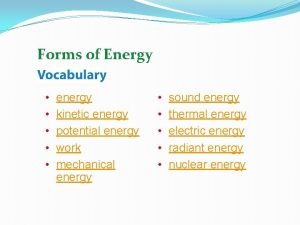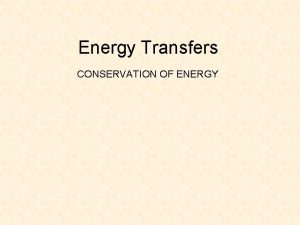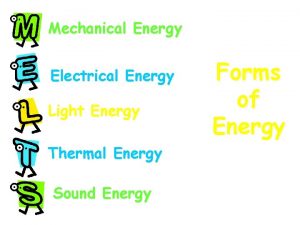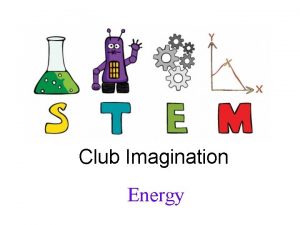What is Energy What is Energy Definition Energy




































- Slides: 36

What is Energy?

What is Energy Definition: Energy is a scalar quantity associated with the state (or condition) of one or more objects. Some characteristics: 1. Energy can be transformed from one type to another and transferred from one object to another. 2. The total amount of energy is always the same (energy is conserved). In this lecture, we are going to look at mechanical energy which comes in two parts: Kinetic Energy and Potential Energy

Kinetic Energy Kinetic energy K is energy associated with the state of motion of an object. The faster the object moves, the greater is its kinetic energy. For an object of mass m whose speed v is well below the speed of light, The SI unit of kinetic energy (and every other type of energy) is the joule (J), 1 joule = 1 J = 1 kg·m 2/s 2.

Kinetic Energy Concept Question Two balls of equal size are dropped from the same height from the roof of a building. One ball has twice the mass of the other. When the balls reach the ground, how do the kinetic energies of the two balls compare? a) The lighter one has one fourth as much kinetic energy as the other does. b) The lighter one has one half as much kinetic energy as the other does. c) The lighter one has the same kinetic energy as the other does. d) The lighter one has twice as much kinetic energy as the other does. e) The lighter one has four times as much kinetic energy as the other does

Example Problem A car is traveling at 15 m/s and has a KE of 200 k. J. What is the KE of the car have as the velocity is changed to 30 m/s and 45 m/s?

Example Problem A car is traveling at 15 m/s and has a KE of 200 k. J. What is the KE of the car have as the velocity is changed to 30 m/s and 45 m/s? Remember KE is defined as So, if the velocity increases by a factor of C, the kinetic energy will increase by a factor of C 2. Notice that 30 m/s is twice the initial speed of 15 m/s. So, C = 2 in this case (30/15 = 2). Thus, KE 2 = C 2*KE 1 = 22* 200 k. J = 4* 200 k. J = 800 k. J

Example Problem A car is traveling at 15 m/s and has a KE of 200 k. J. What is the KE of the car have as the velocity is changed to 30 m/s and 45 m/s? Remember KE is defined as So, if the velocity increases by a factor of C, the kinetic energy will increase by a factor of C 2. Notice that 30 m/s is twice the initial speed of 15 m/s. So, C = 2 in this case (30/15 = 2). Thus, KE 2 = C 2*KE 1 = 22* 200 k. J = 4* 200 k. J = 800 k. J If the velocity is now 45 m/s, that’s 3 times the original speed of 15 m/s. This means KE 3 = C 2*KE 1 = 32* 200 k. J = 9* 200 k. J = 1800 k. J

Work, W, is energy transferred to or from an object by means of a force acting on the object. Energy transferred to the object is positive work, and energy transferred from the object is negative work.

To calculate the work a force F does on an object as the object moves through some displacement d, or Δx, we use only the force component along the object’s displacement. The force component perpendicular to the displacement direction does zero work. For a constant force F, the work done W is: Work A constant force directed at angle f to the displacement (in the x-direction) of a bead does work on the bead. The only component of force taken into account here is the xcomponent. When two or more forces act on an object, the net work done on the object is the sum of the works done by the individual forces.

Work Concept Question Consider the box in the drawing. We can slide the box up the frictionless incline from point A and to point C or we can slide it along the frictionless horizontal surface from point A to point B and then lift it to point C. How does the work done on the box along path A-C, WAC, compare to the work done on the box along the two step path A-B-C, WABC? a) WABC is much greater than WAC. b) WABC is slightly greater than WAC. c) WABC is much less than WAC. d) WABC is slight less than WAC. e) The work done in both cases is the same.

Power The time rate at which work is done by a force is said to be the power due to the force. If a force does an amount of work W in an amount of time t, the average power due to the force during that time interval is or The SI unit of power is the Watt (W). In the British system, the unit of power is the footpound per second. Often the horsepower is used.

Example Problem 1. How much work is done if an applied force of 500 N moves an object 7. 25 m? 2. What is power output of an engine performing 4000 J of work in 5 s? 3. How much work is done to lift an object weighing 400 N to a height of 3 m? 4. How much power is required to lift the 300 N object 2 m in 3 s?

Example Problem 1. How much work is done if an applied force of 500 N moves an object 7. 25 m? W = F * d = 500 N * 7. 25 m = 3, 625 J 2. What is power output of an engine performing 4000 J of work in 5 s? 3. How much work is done to lift an object weighing 400 N to a height of 3 m? 4. How much power is required to lift the 300 N object 2 m in 3 s?

Example Problem 1. How much work is done if an applied force of 500 N moves an object 7. 25 m? W = F * d = 500 N * 7. 25 m = 3, 625 J 2. What is power output of an engine performing 4000 J of work in 5 s? P = W/Δt = 4000 J/5 s = 800 W 3. How much work is done to lift an object weighing 400 N to a height of 3 m? 4. How much power is required to lift the 300 N object 2 m in 3 s?

Example Problem 1. How much work is done if an applied force of 500 N moves an object 7. 25 m? W = F * d = 500 N * 7. 25 m = 3, 625 J 2. What is power output of an engine performing 4000 J of work in 5 s? P = W/Δt = 4000 J/5 s = 800 W 3. How much work is done to lift an object weighing 400 N to a height of 3 m? W = F* d =400 N * 3 m = 1200 J 4. How much power is required to lift the 300 N object 2 m in 3 s?

Example Problem 1. How much work is done if an applied force of 500 N moves an object 7. 25 m? W = F * d = 500 N * 7. 25 m = 3, 625 J 2. What is power output of an engine performing 4000 J of work in 5 s? P = W/Δt = 4000 J/5 s = 800 W 3. How much work is done to lift an object weighing 400 N to a height of 3 m? W = F* d =400 N * 3 m = 1200 J 4. How much power is required to lift the 300 N object 2 m in 3 s? W = F * d = 300 N * 2 m = 600 J P = W/Δt = 600 J /3 s = 200 W

Potential Energy Technically, potential energy is energy that can be associated with the configuration (arrangement) of a system of objects that exert forces on one another. Some forms of potential energy: 1. Gravitational Potential Energy, 2. Elastic Potential Energy The change ΔU in potential energy is defined as being equal to the negative of the work done on the object by the force:

Conservative and Non-conservative Forces Suppose: 1. A system consists of two or more objects. 2. A force acts between a particle-like object in the system and the rest of the system. 3. When the system configuration changes, the force does work (call it W 1) on the object, transferring energy between the kinetic energy of the object, K, and some other type of energy of the system. 4. When the configuration change is reversed, the force reverses the energy transfer, doing work W 2 in the process In a situation in which W 1=-W 2 is always true, the other type of energy is a potential energy and the force is said to be a conservative force. A force that is not conservative is called a non-conservative force. The kinetic frictional force and drag force are nonconservative.

Determining Potential Energy Gravitational A particle with mass m moving vertically along a y axis (the positive direction is upward). As the particle moves from point yi to point yf, the gravitational force does work on it. The gravitational potential energy associated with a particle– Earth system depends only on the vertical position y (or height) of the particle relative to the reference position y =0, not on the horizontal position.

Determining Potential Energy Elastic In a block–spring system, the block is moving on the end of a spring of spring constant k. As the block moves from point xi to point xf , the spring force Fx =- kx does work on the block. The corresponding change in the elastic potential energy of the block–spring system is

Potential Energy Concept Question A donkey pulls a crate up a rough, inclined plane at constant speed. Which one of the following statements concerning this situation is false? a) The gravitational potential energy of the crate is increasing. b) The net work done by all the forces acting on the crate is zero joules. c) The work done on the crate by the normal force of the plane is zero joules. d) The donkey does "positive" work in pulling the crate up the incline. e) The work done on the object by gravity is zero joules.

Example Problem What is the gravitational PE of 10 N object at 1 m, 2 m, 3 m above the floor? Remember the U = m*g*h. Notice I’m not given the mass, but I know that W = m*g This means that U=W*h So for h = 1 m, U = 10 N * 1 m = 10 J For h = 2 m, U = 10 N * 2 m = 20 J For h = 3 m, U = 10 N * 3 m = 30 J

Example Problem What is the gravitational PE of 10 N object at 1 m, 2 m, 3 m above the floor? Remember the U = m*g*h. Notice I’m not given the mass, but I know that W = m*g This means that U=W*h So for h = 1 m, U = 10 N * 1 m = 10 J For h = 2 m, U = 10 N * 2 m = 20 J For h = 3 m, U = 10 N * 3 m = 30 J

Example Problem What is the gravitational PE of 10 N object at 1 m, 2 m, 3 m above the floor? Remember the U = m*g*h. Notice I’m not given the mass, but I know that W = m*g This means that U=W*h So for h = 1 m, U = 10 N * 1 m = 10 J For h = 2 m, U = 10 N * 2 m = 20 J For h = 3 m, U = 10 N * 3 m = 30 J

Example Problem What is the gravitational PE of 10 N object at 1 m, 2 m, 3 m above the floor? Remember the U = m*g*h. Notice I’m not given the mass, but I know that W = m*g This means that U=W*h So for h = 1 m, U = 10 N * 1 m = 10 J For h = 2 m, U = 10 N * 2 m = 20 J For h = 3 m, U = 10 N * 3 m = 30 J

Conservative of Mechanical Energy Principle of conservation of energy: In an isolated system where only conservative forces cause energy changes, the kinetic energy and potential energy can change, but their sum, the mechanical energy Emec of the system, cannot change. The mechanical energy Emec of a system is the sum of its potential energy U and the kinetic energy K of the objects within it: With We have: and

Conservative of Mechanical Energy A pendulum swings back and forth. During one full cycle the values of the potential and kinetic energies of the pendulum– Earth system vary as the bob rises and falls, but the mechanical energy Emec of the system remains constant. The energy Emec can be described as continuously shifting between the kinetic and potential forms. In stages (a) and (e), all the energy is kinetic energy. In stages (c) and (g), all the energy is potential energy. In stages (b), (d), ( f ), and (h), half the energy is kinetic energy and half is potential energy. If the swinging involved a frictional force then Emec would not be conserved, and eventually the pendulum would stop.

Conservation of Mechanical Energy Concept Question A rubber ball is dropped from rest from a height h. The ball bounces off the floor and reaches a height of 2 h/3. How can we use the principle of the conservation of mechanical energy to interpret this observation? a) During the collision with the floor, the floor did not push hard enough on the ball for it to reach its original height. b) Some of the ball’s potential energy was lost in accelerating it toward the floor. c) The force of the earth’s gravity on the ball prevented it from returning to its original height. d) Work was done on the ball by the gravitational force that reduced the ball’s kinetic energy. e) Work was done on the ball by non-conservative forces that resulted in the ball having less total mechanical energy after the bounce.

Example Problem Fill in the KE and PE energy at each point. Assume PE = 200 J and KE = 0 J for position (1) at top. At top all the energy is potential so KE = 0 J PE = 200 J At ¾ to the top, it’s mostly potential but a little kinetic: KE = ¼ * 200 J = 50 J PE = ¾ * 200 J = 150 J At ¼ to the top, it’s still mostly kinetic and a little potential: KE = ¾ * 200 J = 150 J PE = ¼ * 200 J = 50 J At the bottom, it’s all kinetic: KE = 200 J PE = 0 J At the halfway point, it’s both kinetic and potential: PE = ½ * 200 J = 100 J KE = ½ * 200 J = 100 J

Example Problem Fill in the KE and PE energy at each point. Assume PE = 200 J and KE = 0 J for position (1) at top. At top all the energy is potential so KE = 0 J PE = 200 J At ¾ to the top, it’s mostly potential but a little kinetic: KE = ¼ * 200 J = 50 J PE = ¾ * 200 J = 150 J At ¼ to the top, it’s still mostly kinetic and a little potential: KE = ¾ * 200 J = 150 J PE = ¼ * 200 J = 50 J At the bottom, it’s all kinetic: KE = 200 J PE = 0 J At the halfway point, it’s both kinetic and potential: PE = ½ * 200 J = 100 J KE = ½ * 200 J = 100 J

Example Problem Fill in the KE and PE energy at each point. Assume PE = 200 J and KE = 0 J for position (1) at top. At top all the energy is potential so KE = 0 J PE = 200 J At ¾ to the top, it’s mostly potential but a little kinetic: KE = ¼ * 200 J = 50 J PE = ¾ * 200 J = 150 J At ¼ to the top, it’s still mostly kinetic and a little potential: KE = ¾ * 200 J = 150 J PE = ¼ * 200 J = 50 J At the bottom, it’s all kinetic: KE = 200 J PE = 0 J At the halfway point, it’s both kinetic and potential: PE = ½ * 200 J = 100 J KE = ½ * 200 J = 100 J

Example Problem Fill in the KE and PE energy at each point. Assume PE = 200 J and KE = 0 J for position (1) at top. At top all the energy is potential so KE = 0 J PE = 200 J At ¾ to the top, it’s mostly potential but a little kinetic: KE = ¼ * 200 J = 50 J PE = ¾ * 200 J = 150 J At ¼ to the top, it’s still mostly kinetic and a little potential: KE = ¾ * 200 J = 150 J PE = ¼ * 200 J = 50 J At the bottom, it’s all kinetic: KE = 200 J PE = 0 J At the halfway point, it’s both kinetic and potential: PE = ½ * 200 J = 100 J KE = ½ * 200 J = 100 J

Example Problem Fill in the KE and PE energy at each point. Assume PE = 200 J and KE = 0 J for position (1) at top. At top all the energy is potential so KE = 0 J PE = 200 J At ¾ to the top, it’s mostly potential but a little kinetic: KE = ¼ * 200 J = 50 J PE = ¾ * 200 J = 150 J At ¼ to the top, it’s still mostly kinetic and a little potential: KE = ¾ * 200 J = 150 J PE = ¼ * 200 J = 50 J At the bottom, it’s all kinetic: KE = 200 J PE = 0 J At the halfway point, it’s both kinetic and potential: PE = ½ * 200 J = 100 J KE = ½ * 200 J = 100 J

Example Problem Fill in the KE and PE energy at each point. Assume PE = 200 J and KE = 0 J for position (1) at top. At top all the energy is potential so KE = 0 J PE = 200 J At ¾ to the top, it’s mostly potential but a little kinetic: KE = ¼ * 200 J = 50 J PE = ¾ * 200 J = 150 J At ¼ to the top, it’s still mostly kinetic and a little potential: KE = ¾ * 200 J = 150 J PE = ¼ * 200 J = 50 J At the bottom, it’s all kinetic: KE = 200 J PE = 0 J At the halfway point, it’s both kinetic and potential: PE = ½ * 200 J = 100 J KE = ½ * 200 J = 100 J

Conservation of Energy Law of Conservation of Energy The total energy E of a system can change only by amounts of energy that are transferred to or from the system. where Emec is any change in the mechanical energy of the system, Eth is any change in thermal energy of the system, and Eint is any change in any other type of internal energy of the system. The total energy E of an isolated system cannot change.

Conservation of Energy An external force can change the kinetic energy or potential energy of an object without doing work on the object—that is, without transferring energy to the object. Instead, the force is responsible for transfers of energy from one type to another inside the object.
 Energy energy transfer and general energy analysis
Energy energy transfer and general energy analysis Energy energy transfer and general energy analysis
Energy energy transfer and general energy analysis What is the definition of chemical potential energy
What is the definition of chemical potential energy Kinetic energy of a spring
Kinetic energy of a spring Primary energy and secondary energy
Primary energy and secondary energy Hypdro
Hypdro Gibbs free energy
Gibbs free energy Boltzmann entropy equation
Boltzmann entropy equation Equation for efficiency
Equation for efficiency Thermal energy vs heat energy
Thermal energy vs heat energy A hairdryer converts ____ energy into ____ energy.
A hairdryer converts ____ energy into ____ energy. Electric potential energy
Electric potential energy How to convert mechanical energy to electrical energy
How to convert mechanical energy to electrical energy Thermal energy section 3 using thermal energy
Thermal energy section 3 using thermal energy Rt ln k
Rt ln k Helmholtz free energy
Helmholtz free energy What ecological role best describes grizzly bears?
What ecological role best describes grizzly bears? Usable chemical energy in food begins as __________ energy.
Usable chemical energy in food begins as __________ energy. Chapter 7 energy conservation of energy
Chapter 7 energy conservation of energy Indirect form of solar energy
Indirect form of solar energy ________ converts light energy into chemical energy. *
________ converts light energy into chemical energy. * Total energy formula
Total energy formula Potential energy examples
Potential energy examples Electric field to energy
Electric field to energy Definition energy in physics
Definition energy in physics What us energy
What us energy Gravitational potential energy vs kinetic energy
Gravitational potential energy vs kinetic energy Efficiency = useful power output
Efficiency = useful power output Thermal energy and mass
Thermal energy and mass Renewable energy and energy efficiency partnership
Renewable energy and energy efficiency partnership The law of conservation of energy states that
The law of conservation of energy states that Kinetic energy example
Kinetic energy example You and your friend both solve a problem involving a skier
You and your friend both solve a problem involving a skier Formula of potential energy
Formula of potential energy Formula of potential energy
Formula of potential energy Eroei
Eroei Electric current flows in
Electric current flows in

















